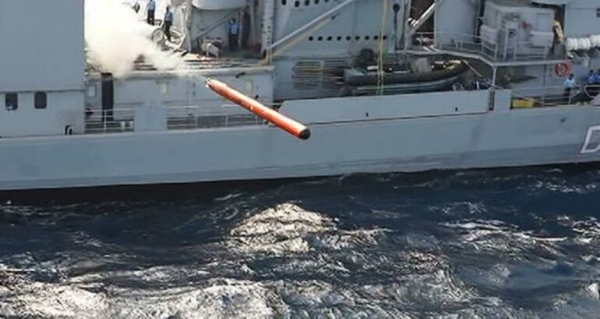Boost for Indian Navy: Indigenous Heavy Weight Torpedo ‘Varunastra’ Destroys Underwater Target
Total Views |
The Indian Navy and Defence Research and Development Organisation (DRDO) have successfully engaged and destroyed an under-water target using 'Varunastra' Heavy Weight Torpedo (HWT).

Defence Spokesperson of Indian Navy tweeted this successful test via its official Twitter handle
Successful engagement of an Underwater Target by an indigenously developed Heavy Weight Torpedo is a significant milestone in #IndianNavy's & @DRDO_India's quest for accurate delivery of ordnance on target in the underwater domain. #AatmaNirbharBharat@DefenceMinIndia pic.twitter.com/ZMSvtFSobE
— SpokespersonNavy (@indiannavy) June 6, 2023
“Successful engagement of an Underwater Target by an indigenously developed Heavy Weight Torpedo is a significant milestone in #IndianNavy's & @DRDO_India's que", said the Tweet.
The Varunastra HWT(Heavy Weight Torpedo) is an electrically-powered torpedo capable of anti-submarine and anti-ship operations. The torpedo has a maximum strike range of 40 kilometres and can travel at speeds of more than 70 kilometres per hour.
Varunastra has been developed by National Science and Technological Laboratory (NSTL), a DRDO lab, specifically established for research and development on marine technology, including torpedoes and sonars.
The DRDO says that Varunastra is capable of targeting submarines “both in deep and shallow waters in an intense counter-measures environment”.
The torpedo is manufactured by Bharat Dynamics Limited (BDL). BDL signed a contract worth Rs 1,187 crore with the Indian Navy to manufacture the weapon.
The first Varunastra torpedo was delivered to the Indian Navy on November 2020.
Varunastra Torpedo will make INDIA self-reliant in development of Modern technologies & will make INDIA as a Pioneer among 8 countries to have capabilities of developing such a indigenous weapon.
• The Varunastra weighs 1.5 tons and carries a 250-kg warhead.
• The heavyweight underwater weapon is between 23 and 26 feet long (7-8 meters) and has a diameter of 533 mm – this dimension is derived from the British 21-inch torpedo first seen in use before the First World War.
• The warhead is of an insensitive type that does not get triggered unless the onboard computers signal it to, making it suitable for a wide variety of combat scenarios.
• The torpedo shell is made of high-strength aluminium alloy, thereby giving it excellent structural rigidity and resilience to circumferential stress.
• The Varunastra is powered by a DRDO-developed enhanced silver oxide-zinc battery system rated at 250kW and can reach depths of up to 400 meters.
• The battery uses zinc as the anode, silver oxide as the cathode and potassium hydride as the electrolyte.
• The silver oxide-zinc battery delivers a voltage of 400V, a current of 625A and gets discharged within 5 minutes once the weapon is fully armed.
• Varunastra’s batteries have a life of up to five years and can tolerate tremendous pressure and stress.
• Another very important advantage of using a silver oxide-zinc battery is its excellent performance in low temperatures, making it perfect for undersea use.
• The Varunastra heavy-weight torpedo can reach a maximum speed of 40 knots, or 74 kmph, making it the third fastest of its kind in the world, after the Mk 48 ADCAP (Advanced Capability) and the WASS Black Shark torpedoes.
• Like most modern weapons of its kind, the indigineously-built Varunastra has a dual guidance system which includes wire-guidance and active-passive acoustic homing.
• The active acoustic homing system in the Varunastra directs itself based on the echoes received in response to sound-pulses generated on-board, much like a SONAR.
• The sound pulses are generated and received by pressure-transducers, and the Varunastra has three such transducers mounted on the front and on both sides of the body.
• When a transducer receives an echo from an object, the navigation system turns the warhead towards the source.
• The wire-guidance is via a thin-wire, which is also a communication medium between the torpedo and the firing ship.
• DRDO has also developed a 26-km-long guidance wire divided across two spools, which is being used in the Varunastra.
• The 26-km-wire is interconnected by an underwater connection and can take pressures of up to 40bar.
• The submarine-launched version of the Varunastra will be guided via a fibre-optic channel and will feature an improved front-end seeker.
• If the target is located at a range exceeding 40km, the torpedo uses its acoustic homing to locate it.
• The torpedo changes direction via hydraulically controlled fins that adjust their position according to the homing signals received by the three pressure transducers on board.
• A key factor in improving the Varunastra’s performance and accuracy is the use of autonomous guidance algorithms and low-drift navigation systems.
• In case the enemy uses countermeasures, the Varunastra can be guided via Global Positioning System (GPS), and the DRDO claims the Indian heavyweight torpedo is the first in the world to have added this to its tech suite.
• The closest is the Boeing-built HAAWC ALA (High-Altitude Anti-Submarine Warfare Weapon Capability Air Launched Accessory) with GPS guidance, an add-on to the Raytheon MK 54 lightweight torpedo used in the Poseidon P8A anti-sub aircraft.
• The Varunastra can be used both for littoral and for deep-water defence, making it a true multi-environment weapon system.


